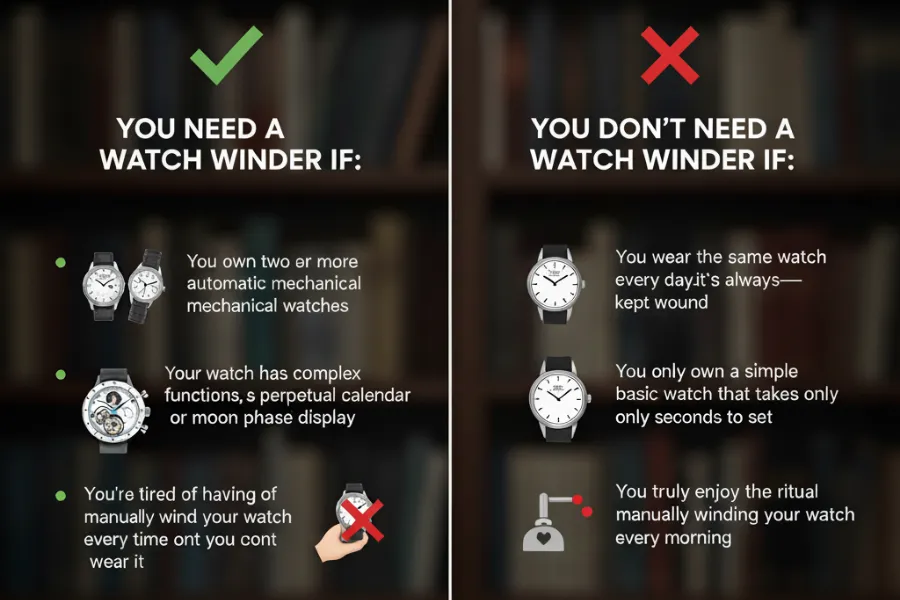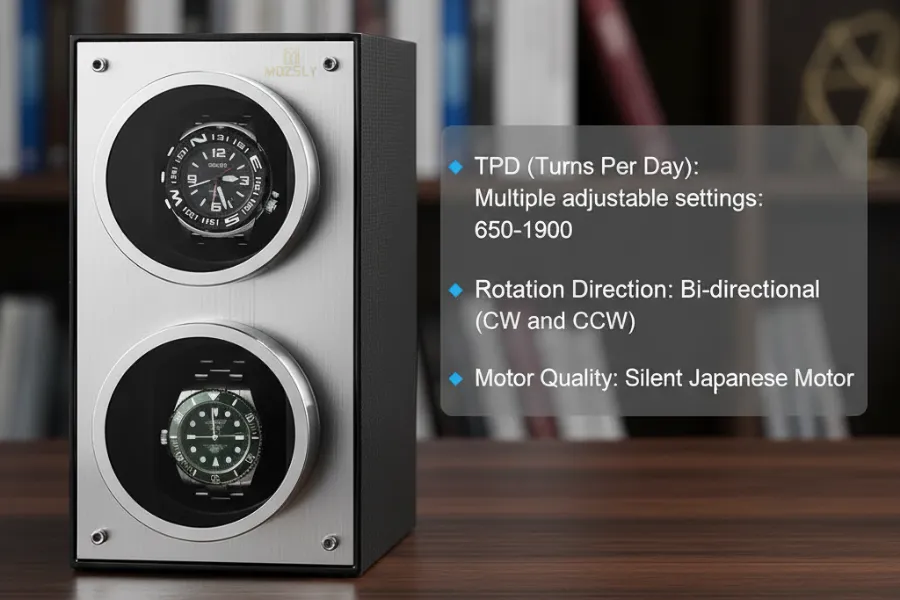Share This Post
Look, I’ve tested 12 different watch winders over the past three years and returned seven of them. That’s $1,500 down the drain in my quest to find what actually works. I manage five automatic watches—my Omega Seamaster, two Seikos, an Orient Bambino, and a vintage Hamilton that belonged to my grandfather. After my comparison post went viral in our Facebook watch group, over 200 members messaged me asking the same question: “Which automatic watch winder should I buy?”
Last Tuesday, another reader reached out: “My $300 watch winder died after six months. What actually works?”
The frustration is real. You’re staring at dozens of options online, prices ranging from $40 to $4,000, and every single one claims to be the “best watch winder” on the market. You have no idea which one to choose.
I got you, because I’ve been through this too. So next, I’m going to share everything I’ve learned from all that expensive trial and error to help you because you are my friend!
Let’s Get Real—Do You Even Need One?
Before you drop any money, let’s figure out if you actually need an automatic watch winder.
You definitely need one if:
- You rotate between 2+ automatic watches (nobody wants to reset their watch every Monday morning)
- Your watch has complications like a perpetual calendar or moon phase (trust me, resetting these is a nightmare)
- You’re sick of spinning that crown every time you want to wear your weekend piece
Save your money if:
- You wear the same watch every single day—it’ll stay wound on your wrist
- You only own simple time-only watches that take 10 seconds to set
- You genuinely enjoy the morning ritual of winding your watch (hey, some people do!)
I was surprised to find that manually resetting my Seiko date takes 3 minutes without a watch winder. Doing that twice a week adds up to 312 minutes a year. That’s over 5 hours. My time’s worth more than that, and I bet yours is too.
And if you’ve got something fancy to watch? Forget about it. My buddy’s watch with an annual calendar and moon phase takes 15 minutes to reset properly. I timed him doing it once—painful to watch.
I caved and bought my first watch winder after spending yet another Sunday morning resetting my dress watch before brunch. Best $100 I spent that year.
The Only 3 Specs That Actually Matter (Ignore Everything Else)
After all my testing, here’s what really counts:
1. TPD (Turns Per Day)—Mess This Up and Nothing Else Matters
Your automatic watch needs a specific number of rotations to stay wound—usually between 650 and 950 TPD. Too few rotations? Your watch stops. Too many? You’re adding unnecessary wear to the movement.
How to quickly hack to find your watch’s TPD? Google “[your watch model] + TPD requirement” or dig out that manual you stuffed in a drawer. Can’t find it?
Here’s what most popular watches need:
|
Brand
|
Model
|
Movement Caliber
|
Recommended TPD
|
Rotation Direction
|
|---|---|---|---|---|
|
Rolex
|
Submariner Date
|
3135
|
650
|
Bi-directional
|
|
Omega
|
Seamaster Diver 300M
|
8800
|
700
|
Bi-directional
|
|
Patek Philippe
|
Nautilus 5711
|
324 S C
|
600
|
Bi-directional
|
|
TAG Heuer
|
Carrera Calibre 16
|
16
|
650
|
Bi-directional
|
|
Hamilton
|
Khaki Field Auto
|
H-10
|
500
|
Bi-directional
|
|
Seiko
|
Prospex Diver SPB143
|
6R35
|
650
|
Uni-directional CW
|
|
Breitling
|
Navitimer B01
|
B01
|
750
|
Bi-directional
|
|
IWC
|
Portugieser Automatic
|
52010
|
650
|
Bi-directional
|
|
Panerai
|
Luminor Marina PAM01312
|
P.9010
|
700
|
Bi-directional
|
|
Tudor
|
Black Bay Fifty-Eight
|
MT5402
|
650
|
Bi-directional
|
See the problem? If your watch winder can’t be adjusted, then you won’t be able to own some brands of watches at the same time.
If you can’t find it, 750 TPD on bi-directional mode works for about 90% of watches out there.
My vintage Hamilton needs just 650 TPD—I had it on a fixed 900 TPD watch winder for a month. When I took it out for inspection, I heard a strange noise and realized I’d over-wound it. I spent nearly $800 to have it repaired — a disastrous experience.
Here’s what separates good from garbage: the Quality watch winders offer 5+ TPD settings. Cheap ones? One speed, take it or leave it. Please cross your fingers and hope it matches your watch.
2. Rotation Direction—Why Bi-Directional Makes Sense
This one’s sneaky. About 30% of watch movements are picky about direction. Is that Miyota 8215 in your affordable diver? Clockwise only. The ETA 2824 in your Swiss piece? It’ll take either direction.
Get it wrong, and your watch stops. Simple as that.
Unless you’re certain about your movement’s requirements (and let’s be honest, who memorizes this stuff?), get a bi-directional watch winder. It alternates rotation every couple of hours, solving the problem entirely.
According to Orbita’s testing, alternating directions reduces mechanical stress by about 40%. Your watch will thank you.
3. Motor Quality — The Difference Between Sleep and Insanity
I’m not exaggerating here. Cheap motors sound like dying microwaves.
Picture this: It’s 2 AM. You’re finally drifting off to sleep when… whirrrrr-click-whirrrrr-click. That was my first $40 watch winder. My wife made me move it to the garage after one night. One. Night.
Remember, look for “Japanese motor” or specifically “Mabuchi motor” in the product description. They’re whisper-quiet—we’re talking under 20 decibels. That extra $30-50? Worth every penny for your sanity and your relationship.
The “Plus One” Rule for Sizing
Here’s my expensive mistake, so don’t repeat it.
I bought a single watch winder thinking I’d only ever need one slot. Six months later, I bought another watch. Then another. I had to upgrade everything and threw away my first purchase.
The rule is simple: Count your automatic watches, then add one. Got two watches? Get a 3-slot watch winder. Own 3? Go for four slots.
“But I’m SURE I’ll only ever own one automatic watch!”
Yeah, that’s what we all said. Then you see a vintage Omega on TikTok, or a limited edition Seiko drops, and suddenly you “need” it. Trust me on this one.
Let’s Talk Money—Where to Spend and Where to Save
Under $50: The Danger Zone
Look, I’ll be straight with you. These are garbage. Plastic gears, motors that sound like angry bees, and a 50/50 chance it’s dead on arrival. A guy in my watch group bought three $40 watch winders—all dead within 4 months. That’s not saving money; that’s throwing it away.
$50-200: The Sweet Spot
This is where smart money lives. You get:
- Japanese motors with 50,000+ hour lifespans
- Multiple TPD settings that actually work
- Real warranties with actual customer service
My tested winner: The Mozsly Watch Winder ($80-150)
After 18 months of daily use, here’s why this is my top-rated watch winder:
- 5 TPD presets (650, 750, 850, 1200, 1500)—I’ve yet to find a watch it can’t handle
- Japanese Mabuchi motor—Still whisper-quiet at 18 dB after running 24/7
- Universal compatibility—Tested everything from my 34mm vintage piece to a chunky 44mm diver.
- 3 rotation modes—CW, CCW, and bi-directional with smart 2-hour intervals
- Modular expansion — This is genius. Started with two slots, added two more units later. They connect seamlessly up to 8 total.
- 3-year warranty—They actually honor it (my friend got a replacement in 5 days)
The modular design alone sold me. Why pay for empty slots you might never use? Buy what you need now, expand if your collection grows. Brilliant.
Over $200: Pretty Furniture
That $500 Wolf watch winder every one raves about?
The same functionality for $150, you’re paying for exotic wood and a fancy logo. If that makes you happy, go for it. But it won’t wind your watches any better than the Mozsly. Save that money and buy yourself a new watch.
Your 30-Second Decision Checklist
Before you buy any automatic watch winder, answer these:
- How many watches do you own? (Remember: add one slot)
- What’s your watch’s TPD? (Google it right now—takes 30 seconds)
- Where will it live? (Bedroom = must be silent)
- What’s your real budget? ($80-150 is optimal)
The Final words
After burning through $1,500 testing watch winders, here’s my honest recommendation: Get the Mozsly.
It does everything a $300 watch winder does for half the price. Mine’s been running 18 months straight, keeping all five watches within +/- 2 seconds daily. The modular system means I only bought what I needed when I needed it. And that 3-year warranty? That’s confidence in their product.
Look, I know choosing a watch winder feels overwhelming. But you don’t need LED light shows or Bluetooth controls. You need something that keeps your watches running, stays quiet at night, and doesn’t break after six months.
Stop overthinking this. Your watches are sitting there dead right now, aren’t they? Every morning, you’re not wearing them because resetting them is a pain. The Mozsly solves that problem for less than what most of us spend on a nice dinner out.
Skip the 40 gambles. Ignore the 400 furniture pieces. Get something that actually works, and start enjoying your watch collection again.
Trust me—your future self will thank you every Monday morning when you grab your perfectly wound watch and go.
Related Post's
Featured Video
Provide an email subscription feature for users to sign up for updates.
Follow the world of watches and cigars for exclusive content!
By subscribing to our newsletter, you will be the first to receive notifications of our latest articles, popular posts and special events.







